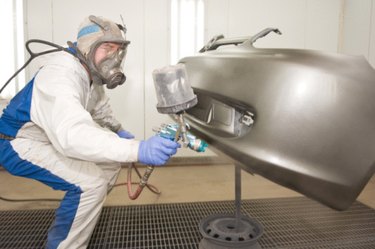
Conventional spray guns use a compressor to atomize the paint particles, with the older models containing paint cups below the air trigger that were fed by a siphon. HVLP (high volume, low pressure) spray guns commonly use a gravity-fed system in which the cup is located on top of the gun or a pressure-assist system in which the cup is mounted beneath the gun and contains a separate air line to feed paint to the gun. It is possible to buy kits that convert conventional guns into HVLP guns.
Air Pressure
Video of the Day
Differences in air pressure output are significant in conventional vs. HVLP guns. Conventional guns use high pressure to produce high volumes of paint, with the PSI values at the inlet the same as the outlet. HVLP guns' PSI values at the outlet are considerably lower than the inlet; for example, according to WoodSprayGuns.com, 18 to 50 PSI at the inlet may be required to produce 10 PSI at the outlet. The reduced pressure of HVLP gun means that you have less overspray and wasted paint but also reduced paint volume.
Video of the Day
Spray Finish
Conventional air spray guns use a LVHP (low volume, high pressure) system, consisting of a compressor that produces fine atomization and can be used on a wide array of surfaces. Modern HVLP guns spray a thicker coat of paint than conventional guns, but the paint droplets are bigger and not as finely atomized and this often results in an "orange peel" or splotchy application.
Transfer Efficiency
HVLP guns have a higher transfer efficiency rate and create less waste than conventional guns, resulting in less wasted paint and lower clean-up costs. According to the Environmental Protection Agency (EPA), conventional spray guns produce a 40-percent transfer efficiency rating compared to up to 60 percent for properly-trained HVLP operators. However, strategies for increasing transfer efficiencies for conventional guns include optimizing the fan size and reducing the air pressure and fluid pressure.
Pollution
Since conventional spray guns contain more over-spray, they release more VOCs (volatile organic compounds) into the environment. Filters for conventional spray guns are often used in painting booths to separate paint particulates, which are then treated by a water scrubber that separates the paint into a sump for disposal.
An HVLP gun emits less "blowback" to the operator and releases less VOCs into the environment. According to the EPA, the isocyanates contained in primers may be extremely dangerous to humans in small quantities and is the leading cause of occupational asthma.